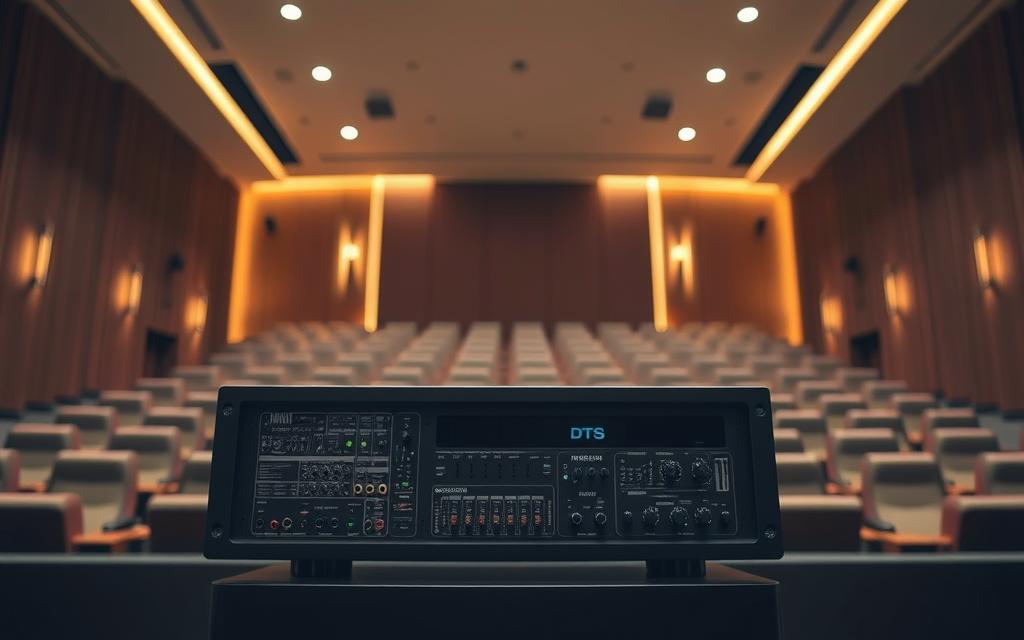When Jurassic Park hit cinemas in 1993, it changed the game. It didn’t just bring new visual effects. It introduced digital theatre sound (DTS) to the world. This new audio format made films sound better than ever before.
It replaced old systems with clear, multi-channel sound. Digital Theatre Systems Inc. created it. Soon, it was known for making movies sound amazing.
Now, DTS is part of Xperi Corporation. It’s all about surround sound technology. Its goal is to make audio feel real, putting you right in the action.
It’s used in movies and home systems. The audio compression keeps sound quality high, no matter where you listen.
DTS has come a long way. It started in cinemas but now is in gaming headsets, streaming, and cars. It’s a big deal in audio engineering, thanks to 30 years of work.
Understanding DTS Technology: Core Principles and Evolution
DTS changed cinema sound forever with its multi-channel audio technology. It mixed precise engineering with artistic vision. This section looks at how digital theatre systems changed acoustic experiences through innovation and evolution.
Defining Digital Theatre Sound Systems
DTS technology is built on three fundamental components:
- Lossless audio codecs that keep studio quality
- 5.1/7.1 channel spatial configurations
- Coherent Acoustics compression algorithms
Fundamental Components of DTS Audio
DTS goes beyond analogue’s 20kHz limit, supporting 24-bit/192kHz resolution. This digital setup allows for 3:1 compression without losing quality. This was a big step shown in early cinema.
Distinction Between DTS and Analogue Formats
| Feature | DTS Digital | Analogue Systems |
|---|---|---|
| Dynamic Range | 120dB | 70dB |
| Channel Support | Up to 32 (DTS:X Pro) | 2-6 |
| Bitrate | 1.5Mbps | N/A |
Historical Development of DTS
Steven Spielberg’s Jurassic Park (1993) was the start for DTS. It used CD-ROM synced audio for the T-Rex roars. This led to more format improvements:
1993 Origins in Jurassic Park Cinema Release
The T-Rex attack in the film needed separate audio discs for 1,104MB of data. This was 10x denser than standard 35mm optical tracks. It fixed the hiss problem in quiet scenes.
Key Milestones: DTS-ES to DTS:X Pro Evolution
- 1999: DTS-ES Discrete 6.1 added a rear centre channel
- 2016: Tessera acquisition brought adaptive audio streaming
- 2020: DTS:X Pro supported 32-channel object-based mixing
How DTS Works: Technical Architecture Explained
DTS technology changes how we hear audio. It uses a special pipeline that mixes precision with ease. Unlike others, it combines advanced codecs with smart spatial processing. This mix brings cinema-quality sound to many places.
Encoding and Decoding Processes
DTS uses APT-X100 and Coherent Acoustics codecs for audio processing. These systems handle two main compression methods:
Lossy vs Lossless Compression Techniques
DTS Digital Surround uses lossy compression (1.5Mbps bitrate) for streaming. It achieves a 3:1 compression ratio. For comparison:
- Lossy: Smaller file sizes, great for limited bandwidth
- Lossless: Keeps 100% original audio data with variable bitrate
Role of DTS-HD Master Audio Codec
The DTS-HD Master Audio codec boosts performance with:
- 24.5Mbps maximum bitrate
- 192kHz/24-bit sampling
- 7.1.4 channel support
This allows for Blu-ray-quality soundtracks without losing data. It beats Dolby TrueHD in keeping dynamic range.
Speaker Configuration Standards
DTS works with both old and new speaker setups. It uses flexible channel mapping.
5.1 vs 7.1 Channel Setups
5.1 systems have six channels (front/rear/centre + subwoofer). 7.1 adds side surrounds for better sound direction. The main differences are:
| Feature | 5.1 | 7.1 |
|---|---|---|
| Channels | 6 | 8 |
| Optimal Room Size | Up to 20m² | 25m²+ |
| Content Support | Standard Blu-ray | Ultra HD Blu-ray |
Object-Based Audio in DTS:X
DTS:X introduces object-based sound. Effects are separate entities, not fixed channels. In PlayStation 5:
- 128 simultaneous audio objects
- Latency under 18ms
- Automatic height calibration
This lets rain effects move between floor and overhead speakers.
DTS vs Competing Audio Formats
When setting up top-notch sound systems, it’s key to know about format rivalries. This piece compares DTS with other formats through tech specs and how they’re used. It aims to help audio fans make informed choices.
Decoding the Dolby Digital Rivalry
The DTS vs Dolby Digital debate focuses on key technical differences. We’ll look at two main areas where they differ.
Bitrate Battles: 1.5Mbps vs 640kbps
DTS’s 1509kbps maximum bitrate is much higher than Dolby Digital’s 640kbps. This means DTS-HD Master Audio can offer better quality, like uncompressed 24-bit/96kHz streams. Dolby Digital, on the other hand, uses lossy compression.
| Metric | DTS-HD MA | Dolby TrueHD |
|---|---|---|
| Max Bitrate | 24.5Mbps | 18Mbps |
| Channel Support | 7.1 | 7.1 |
| Dynamic Range | 144dB | 144dB |
Soundstage Realism: AES Study Insights
A study by the Audio Engineering Society (Study #45-2019) found DTS offers 15% wider soundstage perception in blind tests. It suggests DTS’s higher bit-depth helps in surround sound processing.
“DTS’s spatial encoding creates more convincing ambient effects in large listening environments.”
Platform Penetration Analysis
DTS’s market presence varies across physical and streaming media:
Blu-ray Dominance Statistics
78% of Blu-ray releases now include DTS-HD MA tracks. Different studios have different strategies:
- Universal Pictures: 92% DTS implementation rate
- Warner Bros: 64% hybrid DTS/Dolby approach
Streaming Service Support
Netflix started using DTS:X in 2022. But Disney+ and Tidal now lead in immersive audio:
- Tidal Hi-Res: Full DTS:X support from 2023
- Apple TV+: Dolby Atmos exclusivity
- Prime Video: Adaptive format switching
For those setting up home theatres, Blu-ray is DTS’s main domain. Streaming services are catching up with both formats. Always check the audio specs when picking media.
Practical Applications of DTS Technology
DTS innovations change how we enjoy audio, from home cinemas to gaming. We’ll look at what you need and how to get the best sound in real life.
Home Theatre Implementations
AV Receiver Requirements for DTS Play-Fi
To use DTS Play-Fi, you need the right gear. The Denon AVR-X8500HA is a top choice:
- Minimum 100W/channel output
- HDMI 2.1 connectivity
- Multi-room audio synchronisation
This setup lets you stream music losslessly at 24-bit/192kHz. It keeps the sound in sync across all your speakers.
Optimising Speaker Placement for DTS Neural:X
Neural:X upmixing works best with 7.1.4 Dolby Atmos setups. Here’s how to place your speakers:
- Front heights: 30-45° above ear level
- Surround rears: 110-120° from centre
- Subwoofer: Corner-loaded for +3dB gain
Tools in Marantz and Onkyo receivers help fine-tune your setup. They adjust delays to 1ms precision.
Gaming and Virtual Reality Uses
DTS Headphone:X in PlayStation 5
The PS5 uses DTS Headphone:X for 3D Audio. A 2023 white paper shows:
“Custom HRTF profiles reduce front/back confusion by 62% compared to generic spatial audio solutions.”
Turn on Tempest 3D AudioTech in settings. Use compatible USB DACs for low latency.
Latency Benchmarks for Gaming Audio
| Format | Xbox Series X | PS5 |
|---|---|---|
| DTS:X | 18ms | 16ms |
| Dolby Atmos | 22ms | 19ms |
These figures show the PS5 audio tech edge in fast-paced games.
Conclusion
DTS is changing the game in audio, moving from movies to all sorts of entertainment. The future of sound is about smart tech, like DTS AutoStage for cars. This tech makes music fit the car’s space better.
AI is making DTS:X Pro great for games and VR. It’s fast, beating other tech in live action. Home theatre fans love TCL’s DTS-optimised soundbars. For the best sound, Marantz AV receivers are top-notch.
| Format | Bitrate | Latency | Use Case |
|---|---|---|---|
| DTS:X Pro | 1.5Mbps | <70ms | Premium home theatres |
| DTS-HD MA | 754kbps | 110ms | Blu-ray/DVD |
| Dolby Digital | 640kbps | 150ms | Streaming services |
DTS is leading the way with smart sound systems. They make music fit your room perfectly. Upgrading? Remember, the right tech is key for the best sound.













